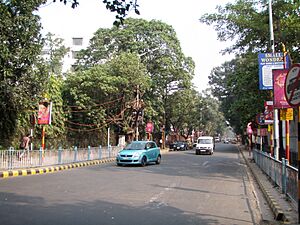Upendranath Brahmachari facts for kids
Quick facts for kids
Upendranath Brahmachari
উপেন্দ্রনাথ ব্রহ্মচারী FRSM FRS
|
|
|---|---|

Sir Upendranath Brahmachari
|
|
| Born | 19 December 1873 Village- Sardanga, Purbasthali, District- Purba Bardhaman (Burdwan) west bengal, British India
|
| Died | 6 February 1946 (aged 72) |
| Alma mater |
|
| Spouse(s) | Nani Bala Devi |
| Children | Phanindra Nath Brahmachari Nirmal Kumar Brahmachari |
| Awards |
|
| Scientific career | |
| Fields | Medicine, Physician |
| Institutions |
|
| Doctoral advisor | Sir Gerald Bomford |
Sir Upendranath Brahmachari (born December 19, 1873 – died February 6, 1946) was a brilliant Indian scientist and a very important doctor. He created a medicine called Urea-Stibamine in 1922. This medicine was a great help in treating a serious disease called Kala-azar.
Early Life and Education
Upendranath Brahmachari was born on December 19, 1873. His birthplace was Sardanga village in West Bengal, India. His father, Nilmony Brahmachari, was a doctor for the East Indian Railways. His mother's name was Saurabh Sundari Devi.
He went to Eastern Railways Boys' High School in Jamalpur for his early studies. In 1893, he earned his BA degree from Hooghly Mohsin College. He studied Mathematics and Chemistry. After that, he decided to study Medicine and advanced Chemistry.
He completed his master's degree in 1894 from Presidency College, Kolkata. In 1900, he was the top student in Medicine and Surgery at the University of Calcutta. He received special awards for his excellent performance. He earned his MD degree in 1902. In 1904, he received his PhD degree for his research on "Studies in Haemolysis." He married Nani Bala Devi in 1898.
Discoveries and Career
Dr. Brahmachari made a huge difference in medicine. In 1922, he created a new medicine called Urea-Stibamine. This medicine became the best treatment for Kala-azar. Kala-azar is a serious disease caused by tiny parasites. Before his discovery, many people died from it. His medicine saved countless lives.
He also found a new, dangerous type of leishmaniasis in 1922. He named it dermal leishmanoid. This disease caused sudden skin rashes on people's faces. It appeared in patients who had partly recovered from Kala-azar. It also affected people who had never had Kala-azar. Today, this condition is known as post-kala-azar dermal leishmaniasis (PKDL).
Awards and Recognition
Dr. Upendranath Brahmachari received many important awards for his work. In 1924, he was given the title of Rai Bahadur. He also received the Kaisar-i-Hind Gold Medal from the Governor General Lord Lytton.
In 1934, the British Government gave him a special honor. He was made a knight. This meant he could use "Sir" before his name.
He was considered for the Nobel Prize in medicine twice. This happened in 1929 and again in 1942. He was also the president of important scientific groups. He led the Indian Science Congress in 1936. He was also the president of the Indian Chemical Society in Calcutta. He was a respected member of the Royal Society of Medicine in London. He also served as the President of the Asiatic Society of Bengal for two years.


